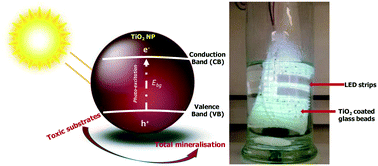Blooms of blue-green algae (cyanobacteria) in water reservoirs frequently produce highly toxic secondary metabolites including microcystins which have resulted in both human and animal fatalities. To tackle this global problem, we present here a viable solution: utilising the photo-catalytic power of TiO2 immobilised on glass beads that are encased in ‘photo-reactor pods’, equipped with UV LEDs, for the photocatalytic destruction of cyanotoxins. These reactor pods are designed in such a way that they can be used continuously with the aid of a power supply to facilitate the photocatalytic process. This process could be used to address one of the Global Challenges: providing safe drinking water around the globe.


